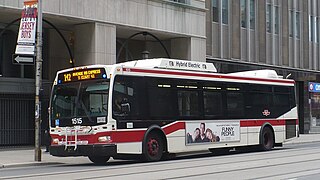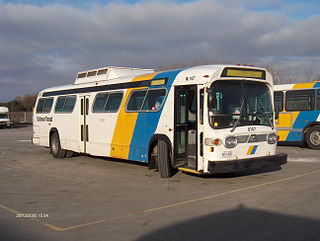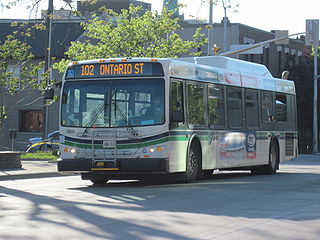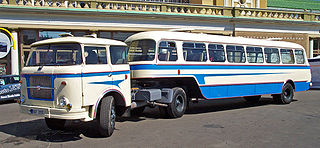
A bus is a motor vehicle that carries significantly more passengers than an average car or van, but less than the average rail transport. It is most commonly used in public transport, but is also in use for charter purposes, or through private ownership. Although the average bus carries between 30 and 100 passengers, some buses have a capacity of up to 300 passengers. The most common type is the single-deck rigid bus, with double-decker and articulated buses carrying larger loads, and midibuses and minibuses carrying smaller loads. Coaches are used for longer-distance services. Many types of buses, such as city transit buses and inter-city coaches, charge a fare. Other types, such as elementary or secondary school buses or shuttle buses within a post-secondary education campus, are free. In many jurisdictions, bus drivers require a special large vehicle licence above and beyond a regular driving license.

The Regional Municipality of Niagara, also colloquially known as the Niagara Region or Region of Niagara, is a regional municipality comprising twelve municipalities of Southern Ontario, Canada. The regional seat is in Thorold. It is the southern end of the Golden Horseshoe, the largest megalopolis in Canada.

The Niagara Frontier Transportation Authority (NFTA) is the public agency responsible for operating most public transportation services in the Buffalo–Niagara Falls metropolitan area. The NFTA, as an authority, oversees a number of subsidiaries, including the NFTA Metro bus and rail system, the Buffalo-Niagara International Airport, the Niagara Falls International Airport and NFTA Small Boat Harbor. The NFTA Metro bus and rail system is a multi-modal agency, utilizing various vehicle modes, using the brand names: NFTA Metro Bus, NFTA Metro Rail, NFTA Metrolink and NFTA PAL. In 2023, the system had a ridership of 15,429,900, or about 54,600 per weekday as of the second quarter of 2024.

An articulated bus, also referred to as a slinky bus, bendy bus, tandem bus, vestibule bus, stretch bus, or an accordion bus, is an articulated vehicle, typically a motor bus or trolleybus, used in public transportation. It is usually a single-decker, and comprises two or more rigid sections linked by a pivoting joint (articulation) enclosed by protective bellows inside and outside and a cover plate on the floor. This allows a longer legal length than rigid-bodied buses, and hence a higher passenger capacity (94–120), while still allowing the bus to maneuver adequately.

The Volvo B7RLE is a low-entry single-deck bus chassis manufactured by Volvo. It was superseded by the Volvo B8RLE in 2013.

The Toronto Transit Commission (TTC) uses buses and other vehicles for public transportation. In 2018, the TTC bus system had 159 bus routes carrying over 264 million riders over 6,686 kilometres (4,154 mi) of routes with buses travelling 143 million kilometres in the year. As of 2021, the TTC has 192 bus routes in operation, including 28 night bus routes. In 2023, the system had a ridership of 362,041,400, or about 1,240,300 per weekday as of the second quarter of 2024.

The Terminal Link is an automated people mover (APM) at Toronto Pearson International Airport in Mississauga, Ontario, Canada. The wheelchair-accessible train runs 24 hours a day, seven days a week and is completely free-of-charge to ride. In 2012, it transported 17,000 passengers daily, 60 to 70% of whom were airport staff.

The Capital District Transportation Authority (CDTA) is a New York State public-benefit corporation overseeing a number of multi-modal parts of public transportation in the Capital District of New York State. CDTA runs local and express buses, including four lines of an express bus service called BusPlus, and day-to-day management of three Amtrak stations in the Capital region–the Albany-Rensselaer, Schenectady and Saratoga Springs Amtrak stations. In 2023, the system had a ridership of 15,779,000, or about 57,100 per weekday as of the second quarter of 2024.

A tourist trolley, also called a road trolley, is a bus designed to resemble an old-style streetcar or tram, usually with false clerestory roof. The vehicles are usually fueled by diesel, or sometimes compressed natural gas.

The London Transit Commission (LTC) is responsible for the operation of the public transit system on behalf of the City of London, Ontario, Canada. It operates transit bus service and para-transit service. In 2014, annual ridership totaled 24.1 million. The LTC has 28 regular bus routes, six express routes, three school-year-only routes and six community bus routes.

Oshawa Transit was a public transit operator in Oshawa, Ontario, Canada, from 1960 to 2005. Its only garage and headquarters was located at 710 Raleigh Avenue in Oshawa.
The Niagara Parks Commission, commonly shortened to Niagara Parks, is an agency of the Government of Ontario which maintains the Ontario shoreline of the Niagara River.

Niagara Falls Transit was a public transit agency that operated the public transport bus services in Niagara Falls, Ontario, Canada between 1960 and 2022.
Accessibility for people with disabilities on the Toronto Transit Commission (TTC) system is incomplete but improving. Most of the Toronto subway system was built before wheelchair access was a requirement under the Ontarians with Disabilities Act (ODA). However, all subway stations built since 1996 are equipped with elevators, and elevators have been installed in 45 stations built before 1996. Over three-quarters of Toronto's subway stations are accessible. The original plan was to make all stations accessible by 2025; however, a few stations might not be accessible until 2026.
TransIT Services of Frederick County is a public transportation agency in Frederick County, Maryland, that is operated by the county government. The agency currently operates 9 Connector bus routes, mostly in the city of Frederick, 5 shuttles, and demand-response for seniors and persons with disabilities. TransIT provides connections to other public transportation services in the region, including the MTA Maryland's routes 204 and 515 commuter bus and MARC Train service. According to the agency's homepage, the service had approximately 909,800 boardings in FY 2012.

The Scania K series is a series of chassis in Scania's city bus and coach range with longitudinally, straight-up mounted engine at the rear, replacing the K- and L-type (L94) chassis of the 4 series. The K series was first presented on Busworld 2005 in Kortrijk, Belgium, and models were available from 2006.

St. Catharines Transit (SCT) was a public transit agency which provided bus services to St. Catharines, Ontario, and the neighbouring city of Thorold. The St. Catharines Transit Commission took over operation of transit services within the city from Canadian National Transportation in 1961. In January 2023, St. Catharines Transit was merged with Niagara Falls Transit, Welland Transit, and Fort Erie Transit to form a single regional transit service, Niagara Region Transit.

A trailer bus is a trailer vehicle designed specifically for the transportation of passengers. Trailer buses typically comprise one of two forms:
Bus companies in Ontario range in scale from small family-run businesses to subsidiaries of large international transportation groups. Many operate yellow school buses for student transportation on behalf of local school boards, while others concentrate on luxury coach charters and tours. Some municipalities use these private companies to run their public transit systems.

WEGO Visitor Transportation System (WEGO) is a bus system in Niagara Falls, Ontario jointly operated by Niagara Region Transit and the Niagara Parks Commission. It replaced Niagara Falls Transit's Falls Shuttle, as well as the Niagara Parks Commission People Mover. Originally scheduled to launch on June 29, 2012, the service's inauguration was postponed due to delays in its buses' intelligent transportation system. WEGO launched its preview service on August 13, 2012, then finally began official operations, a week later, on August 20. WEGO is a pairing of the words "we" and "go". WEGO is not an acronym for anything, however.

















